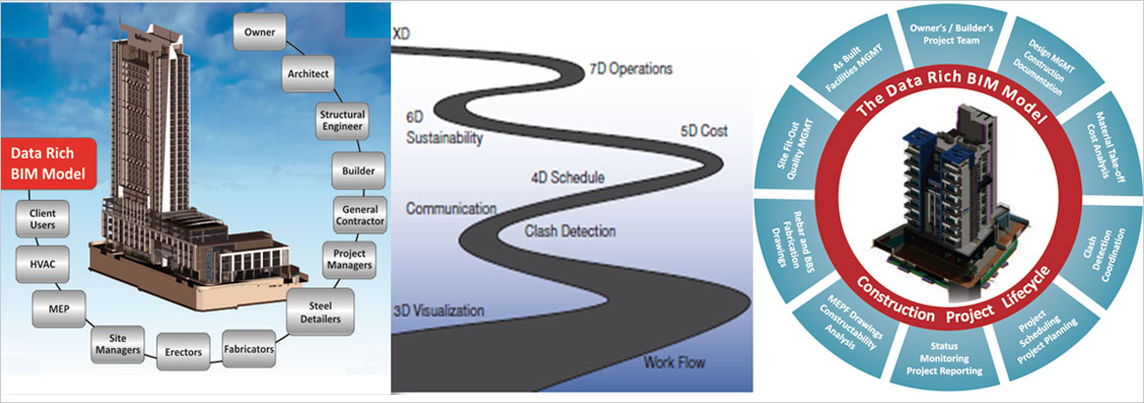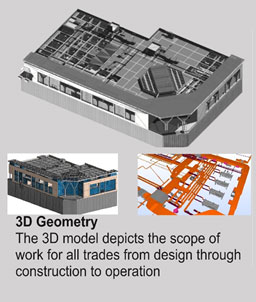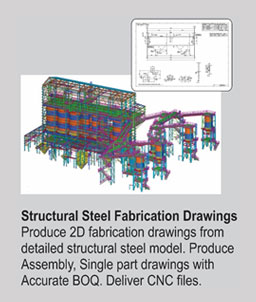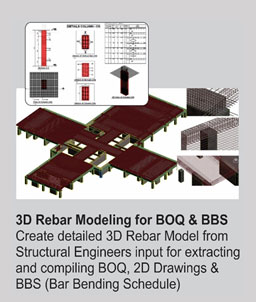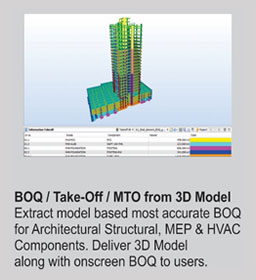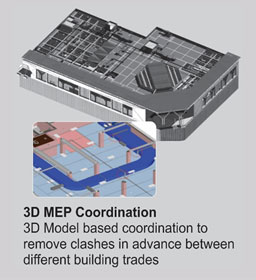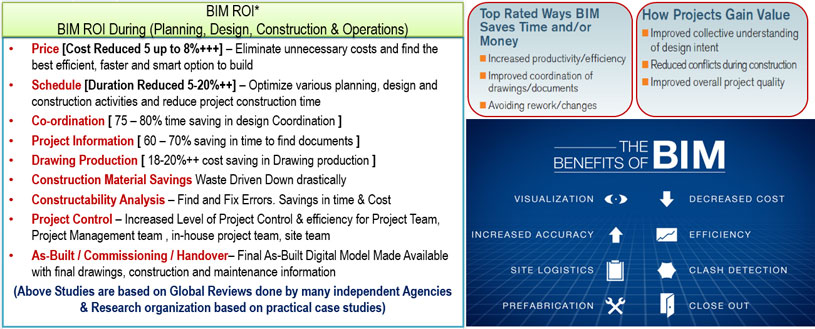BIM Benefits - ROI
BIM isn't just a fancy 3D CAD model. The latter has been around for quite a while and in most cases represents just the visual aspects of a building. BIM is much more; it's about creating a model of the project that actually represents its physical characteristics, its performance, the way it'll be built and anything else of use to the teams involved in designing, building and operating it. Successful BIM delivery in construction sector is not about software, it's about processes and understanding. It's about knowing what you, as a contractor or sub-contractor, require to be delivered from the design phase of a project, how you can use this information for the benefit of your organization, and for the benefit of the client. Ultimately, BIM may be about winning business by producing better bids and then delivering projects on time and on budget for a satisfied client.
Actual BIM usage in an production will define the achievable benefits. Please refer http://bim.psu.edu/Uses/
The Benefits of BIM in Construction : Different organizations and projects will see different benefits from BIM and a different return on investment (37% reported over 25% ROI), particularly over time. However, the key benefits include:
- Improved initial design data
- Better communication/collaboration
- Increased productivity
- Reduced rework
- Reduced cycle time in many workflows
- Improved service to client
- Reduced risk
- More accurate and earlier cost certainty
- Reduced waste
- Improved design and construction sequence understanding
- Facilitates different construction techniques (e.g. pre-fabrication)
- Reduced clashes and resulting conflicts
- Reduced cost
- Marketing purposes and publicity.
- Better understanding of the phasing schedule by the owner and project participants and showing the critical path of the project.
- Dynamic phasing plans of occupancy offering multiple options and solutions to space conflicts.
- Integrate planning of human, equipment and material resources with the BIM model to better schedule and cost estimate the project.
- Space and workspace conflicts identified and resolved ahead of the construction process.
- Identification of schedule, sequencing or phasing issues.
- More readily constructible, operable and maintainable project.
- Monitor procurement status of project materials
- Conveying the spatial complexities of the project, planning information, and support conducting additional analyses
- Increased productivity and decreased waste on job site
Owner Benefits of BIM
A process change that improves the odds of delivering a building on time an on budget.
- Improved design quality, better performing building (systems coordination, engineering analysis)
- Fewer change orders (building systems clash detection)
- Schedule optimization (construction schedule simulation)
- Schedule compression (digital assisted fabrication, offsite fab)
- Efficient handover (data exchange for operations/maintenance)
- Risk reduction (more transparency)
Architect/Engineer Benefits of BIM
A data rich digital representation of a building that allows designers to explore design options, conduct analysis and better communicate design intent.
- Design prototype (space arrangements, assemblies, materials)
- Building systems coordination (space reservation, clash detection)
- Analysis (space, lighting, energy, structural)
- Drawing production quality (flexible, exploits automation, better coordinated)
- Design exploration/interrogation (data rich visual models)
- Engineering accuracy (measurement, context)
Contractor Benefits of BIM
A data rich digital representation of a building that provides a better understanding of the building and assists with construction delivery.
- Risk reduction (better understanding of complexity)
- Building systems coordination (clash detection, layout)
- Shop drawing reduction (model to fabrication)
- Digital fabrication (steel, HVAC ducts, piping)
- Construction schedule optimization (visual schedule simulation)
- Cost estimating (quantity takeoffs)
Team Benefits of BIM
A project delivery process that encourages collaboration and a focus on data management and sharing.
- Efficient processes (forces process re-engineering)
- Improved collaboration (concurrent design, process to rally around)
- Better decisions (better coordinated information)
- Accelerated understanding (graphics + data)
- Efficiencies from reuse of data (enter once use many)
- Improved data quality (less data re-entry, less human error
